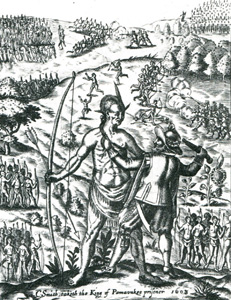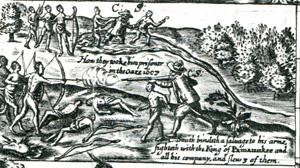.gif)
.gif)


Opechancanough quickly becomes a part of the English’s Jamestown story after encountering Captain John Smith shortly after the arrival of the English in 1607. Smith was captured by a winter hunting party led by Opechancanough near the mouth of the Chickahominy River in December of that year. Although Opechancanough consistently demonstrated a distrust of the English, he nonetheless treated Smith as an honored guest, bestowing him with a feast and entertainment, as well as protection during his stay. In his A True Relation, Smith notes that, “Each morning [three] women presented me three great platters of fine bread; more venison than ten men could devour I had…Though [eight] ordinarily guarded me, I wanted not what they could devise to content me. And still our longer acquaintance increased our better affection.” Eventually Opechancanough delivered Smith to Powhatan at Werowocomoco, Tsenacommacah’s capital on the York River.
For the next decade, Opechancanough only occasionally appears in the English records: assisting Powhatan again in entertaining Smith and Captain Christopher Newport in February 1608, and in preventing Smith's seizure of the Powhatan’s winter food supply early in 1609. He then disappears from the record for five years. During those years, the English continually expanded their settlements beyond Jamestown fort, establishing numerous small communities along the area’s rivers. Conflict became inevitable as the English encroached further into Indian territory, namely the construction of a settlement at Henrico in 1611, resulting in the First Anglo-Powhatan War (1609-1614). While the devastating guerrilla attacks by the Powhatan may have slowed English expansion, the colonists had by now established themselves as a permanent fixture in the Indian’s realm.
Though little is known of Opechancanough’s history, he appears to have been able to establish his independence from Powhatan, demonstrated by his seizing control of the powerful Chickahominy tribe in 1616. When Powhatan surrendered his position as paramount chief, he “left the government of his kingdom to Opechancanough and his other brother [Itoyatan].” Opechancanough served as war-chief of the Powhatan and interacted with “outsiders,” whereas his brother (or cousin) Itoyatan (about whom little is known) acted as the “peace chief” while holding the position of paramount chief, the head of council. This duality of leadership was common in Algonquian culture, but a difficult balance of power for the English to interpret. Because Opechancanough was more visible in his interactions with the English, it is understandable that his role as chief is more extensively mentioned by the English than is Itoyatan’s.
During this period the English continued their expansion in Tsenacommacah. In part, the infamous attacks led by Opechancanough in 1622 and 1644 can be seen as the military leader’s realization that English settlements were growing rapidly and would sooner or later threaten the Powhatan’s way of life. Historians estimate that Opechancanough spent between one and three years planning the attack in 1622, despite maintaining overall friendly relations with the English. On the morning of March 22, 1622, the Indians who had visited the colonists and stayed overnight joined others who entered the James River settlements, some using boats to cross rivers, to launch well-coordinated surprise attacks. The Indians entered the settlements unarmed and when the time came to attack they used the colonists’ own tools and weapons to kill the 347 English men, women, and children that lost their lives that day. Colonist Edward Waterhouse recounted that the Powhatan were “so sudden in their cruel execution that few or none discerned the weapon or blow that brought them to destruction.”
It appears likely that Opechancanough’s ultimate goal in planning the attack was not to exterminate the English but rather to confine them to a small territory, ideally back to a single settlement at Jamestown, or force them to leave. In addition, the war chief hoped to frighten the English into subsequent passivity by demonstrating Powhatan military superiority over that of the colonists. Opechancanough’s hopes were quickly dashed by an immediate English offensive intended to eradicate the Powhatan, but the latter were able to easily escape into the woods. By September, the Powhatan had resumed their guerrilla attacks, and the English experienced more hardship that winter than the Indians, having been too frightened by these attacks to plant corn. By 1632, with both the English and the Powhatan now exhausted, an uneasy peace was agreed upon by both sides and the English continued to expand into Tsenacommacah faster than ever before.
On April 18, 1644, the aging Opechancanough launched the second of his great assaults against the English with little success. Like in 1622, the coordinated attacks took place at various sites close to Powhatan settlements as a single blow rather than a series of chronic battles, followed by a quick retreat. Unlike in 1622, however, the attack appears to have had little effect on the settlers’ way of life. By now, English settlement policies had resulted in larger numbers of settlers. Though more colonists lost their lives in 1644 than in 1622, the dead accounted for a much smaller proportion of the English population, and everyday life soon returned to normal for the majority of the colonists. The English launched a counteroffensive against multiple Powhatan tribes, and in 1646 the Virginia General Assembly authorized a force to locate Opechancanough to initiate peace talks.
The once formidable war-chief was captured by forces under Virginia governor Sir William Berkeley around this time and no longer described as the “king of the Indians.” In October of 1646 a peace agreement was signed by Opechancanough’s predecessor. Opechancanough was thought to be near one hundred years old and “was now grown so decrepit that he was not able to walk alone…and his eyelids became so heavy that he could not see, but as they were lifted up by his servants.” He was captured alive and returned to Jamestown as the governor’s prisoner. Within two weeks of his arrival, the Powhatan leader was shot dead by an irate guard seeking revenge for the misfortunes suffered by the English at the hands of Opechancanough’s warriors. The death of Opechancanough, as well as the 1644 attack, signified the end of the delicate balance of power the Powhatan and English maintained during the first three decades of their coexistence. The English consolidated their superiority by forcing the Powhatan to recognize the sovereignty of the English king, and while the peace treaty recognized the boundaries of the colonists’ settlements, these demarcation lines would soon be unrecognizable in the coming decades.
Applebaum, Robert and John Wood Sweet, eds. Envisioning an English Empire: Jamestown and the Making of the North Atlantic World. Philadelphia: University of Pennsylvania Press, 2005.
Gleach, Frederic W. Powhatan’s World and Colonial Virginia: A Conflict of Cultures. Lincoln: University of Nebraska Press, 1997.
Rountree, H. C. “Opechancanough (d. 1646).” (2011, December 8). In Encyclopedia Virginia. Retrieved November 2013 from http://www.EncyclopediaVirginia.org/Opechancanough_d_1646.
Rountree, Helen C. Pocahontas, Powhatan, Opechancanough: Three Indian Lives Changed by Jamestown. Charlottesville: University of Virginia Press, 2005.
Smith, John. A True Relation of Such Occurrences and Accidents of Noate as Hath Hapned in Virginia [1608]. In Edward Wright Haile, ed. Jamestown Narratives: Eyewitness Accounts of the Virginia Colony, The First Decade: 1607-1617. Champlain, VA: RoundHouse, 1998.
©Crandall Shifflett
All Rights Reserved
2013